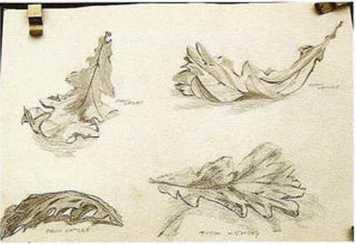essentÊrving°66

Essen ti al Woodcarvixg Techniques

Fig 5.1 Oak leafstudies by a student (Howard Spiers) before beginning the example carved for this chapter. He bas tńed to show them as three-dimensional objects.
fussy if you do and should bc morÄ™ sculptural. The oak leaf which is the subjecc of this chaptcr is 2l6mm (8V^in) long, 104mm (4in) widc, and 25mm (lin) decp. It seems appropriate, although not always easy, to make the leaf with the wood of the same species of tree. The main axi$ of the leaf is along the grain. This facilitates the carving and emphasizes the flow of the leaf. Quarter-sawn wood is the most stable but unnecessary for an exercise of this size.
Holding the Work
Having selected your wood it is cssential that you plan how it is to be held and the stages of carving. The two obvious methods are to carve it as a relief, in which case the background may bc held in a vice or with clamps, or in the round, where a rectangular pług is retained underneath or left around the stem or screwed, or glued with a paper join, to the bottom. In this case, once the accessible parts of the leaf are finished the błock is unscrewed or the pług is carved down, gently shaping the underside of the leaf or the stem until so littlc remains that it can be pared off with a knife.
TRANSFERRING THE DRAWING to the Wood
The safest method of putting the drawing on to the wood is to prepare it on paper. It is rhen far easier to change pencil lines, rather than trying to do it on the wood. The finał drawing is transferred to the wood with carbon paper.
Setting Down the Relief
If the carving is to be a relief, after the design has been drawn on the surface the intended depth should be marked on the sides all the way round. Then the ground should be taken down to this level all around the outline of the leaf. If this is very notched it is best to cut out a simplified outline and set down the fine details later, particularly as some notches may end up ncar the ground.
Figurcs 5.2, 5.3 and 5.4 show thrcc ways of setting down and roughing or hosting out.
The waste wood is carved with a deep gouge away from the outline and right to the edge (Fig 5-2). This may lead to morÄ™ splitting off than was intended. It is also difficult to sec how far down you

FlG 5.2 The quickest method of setting down an outline, by carning downwards away from it. NotÄ™ the ground linÄ™ drawn on the side of the wood.
— 66 _
Wyszukiwarka
Podobne podstrony:
essent?rving?30 Essen ti al Woodcarving Techniques Fig 2.4 A piece of Southern yeUow pine. The dark
essent?rving?96 Essen ti al W o o dcaryinc T e c h niq u e s Fig S.18 Cutting across tbe gmin wbere
essent?rving?18 Essen tul Woodcarning Techniques Fig 1.29 A bench holdfast in use. Fig 1.28 A univer
essent?rving?12 E S S E N TI AL W O O D C A R VI X G TECHNIQ U E S The Nos. 4-7 are gouges whose sha
essent?rving?14 pp Essential Woodcarvixg Techniques W Fig 1.17 Ttoo grounders. Very narrow old Engli
essent?rving?52 Essen’ tial W o o d c a r v i n g Techniques Fig 3.18 A No. 3 fishtail being used to
essent?rving?84 Essential Woodcarving Techniques Fig 7.7 This is how a piece of card would look if f
essent?rving?98 Essential Woodcarving Techniques Fig 9.1 Various lines. The one on the left Incks in
essent?rving?52 Essential Woodcarying Techniques Fig 14.3 Mov mg water. Fig 14.4 Drawings devełoping
essent?rving?28 Essential Woodcarving Techniques Phloem or bast Bark Wood or xylem Roots anchor the
essent?rving?68 Essen tial Woodcarving Techniques FlG 15.16 The fint cut into the serif on an M. Fig
essent?rving?34 Essen tial Woodcarying Techniques softwoods are evergreen and hardwoods are dcciduou
essent?rving?40 Essen tial Woodcarying Techniques FlG 2.20 Arrow Crosstree (Dick Onians), carued in
essent?rving?48 Essen tiał Woodcarving Techxiques Fig 3.5 From the bot tom: two correct chip cuts; t
essent?rving?50 Essen tial W o o d c a r vin g Techniques Fig 3.11 Making the stab aa at too shallow
essent?rving?58 Essen-tial Woodcarvig Techxiques Fig 4.10 Cu tti fig the cup. The gouge en ten the w
essent?rving?72 Essen tial Woodcarving Techniques although the temptarion ro use a router co set clo
essent?rving?10 Essentiai. Woodcarying Techniques Makes of Tool Maker/brand Country Edge-
więcej podobnych podstron